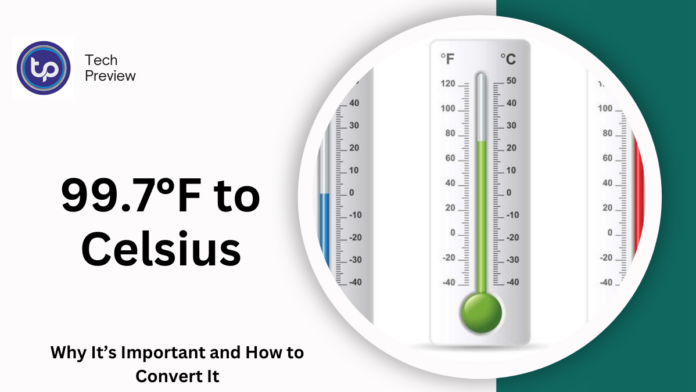Temperature conversions are an essential skill for understanding weather conditions, health measurements, and scientific data across different systems. In many countries, temperatures are measured using Celsius, while in others, like the United States, Fahrenheit is still commonly used.
One frequently encountered conversion is from 99.7°F to Celsius. Understanding how to convert these units is not only practical but essential, especially when tracking body temperature or navigating international travel.
In this article, we’ll break down the process, discuss its relevance, and explain why it’s important to understand this conversion in various aspects of life.
Why Temperature Conversion Matters
Temperature is a fundamental measurement that affects many areas of life, from the weather we experience daily to the health guidelines we follow. The world’s two main temperature systems are Fahrenheit and Celsius.
These systems are used in different parts of the world, which can sometimes lead to confusion when comparing temperatures, especially for health monitoring, weather reports, or scientific studies.
Knowing how to convert between these two scales is vital to understanding global weather patterns, interpreting medical information, or simply making sense of travel conditions in countries using the Celsius scale.
MUST READ: Aesthetic:hfyknqlyygs= Preppy Style: The Perfect Blend of Tradition and Modern Elegance in 2024
Understanding the Conversion Formula
Converting Fahrenheit to Celsius follows a simple, yet essential formula. The equation used to make this conversion is:
C=(F−32)×59C = (F – 32) \times \frac{5}{9}C=(F−32)×95
Where:
- C is the temperature in Celsius.
- F is the temperature in Fahrenheit.
Let’s apply this formula to the temperature 99.7°F to convert it into Celsius.
99.7°F to Celsius: The Conversion
By plugging 99.7°F into the formula:
C=(99.7−32)×59C = (99.7 – 32) \times \frac{5}{9}C=(99.7−32)×95 C=67.7×59C = 67.7 \times \frac{5}{9}C=67.7×95 C≈37.6°CC ≈ 37.6°CC≈37.6°C
So, 99.7°F is approximately 37.6°C. This conversion tells us that 99.7°F is just a little above the normal human body temperature of 98.6°F, or 37°C. It’s important to note that this small difference could be an indicator of a mild fever, depending on the person’s health.
Why Is 99.7°F Important in Daily Life?
In Health and Medicine
The temperature of 99.7°F is often used in medical contexts to monitor body temperature. It is slightly above the average body temperature of 98.6°F, which is widely considered the normal baseline. While this is not classified as a high fever, it is still important to note, especially in a clinical setting.
A temperature around 37.6°C (99.7°F) could be a sign of a mild fever, which might indicate the early stages of an infection or another health issue. Healthcare professionals often use both Celsius and Fahrenheit conversions to assess and track a person’s condition, particularly in regions where different systems are used.
In Global Travel
When traveling abroad, especially to countries that use the Celsius scale, knowing how to convert temperatures like 99.7°F to Celsius can be crucial. For example, understanding what 99.7°F feels like in Celsius can help travelers prepare for different weather conditions, such as extreme heat or cold.
Knowing that 99.7°F is approximately 37.6°C allows travelers to gauge their comfort levels when experiencing temperatures that are hotter than what they’re used to.
In Everyday Life
Conversion between Fahrenheit and Celsius also comes into play in everyday activities like cooking or gardening. For instance, some cooking recipes or temperature settings on ovens may use Celsius.
Understanding that 99.7°F equals 37.6°C can help when interpreting such instructions, ensuring you get the right results whether you’re making bread dough, setting your oven for baking, or checking water temperatures for certain culinary processes.
The Importance of Accurate Temperature Conversion
Precision in Science and Engineering
In scientific research, precise temperature measurements are critical. Whether conducting experiments, managing industrial processes, or monitoring environmental conditions, even small errors in temperature conversion can lead to significant discrepancies in data.
Converting 99.7°F accurately to 37.6°C ensures that processes which depend on exact temperatures, like chemical reactions or biological studies, run smoothly and predictably. Scientific data often requires the precision that only Celsius provides, especially when dealing with water’s freezing and boiling points.
Climate and Weather Forecasting
Weather reports around the world are generally provided in Celsius, making it important for anyone using the Fahrenheit scale to understand these conversions. For example, understanding that 99.7°F is 37.6°C could help you interpret heatwaves or tropical temperatures reported in other parts of the world.
With climate change becoming a growing global concern, accurate temperature measurements are essential for tracking environmental patterns and informing decision-making at governmental and community levels.
Why Do Different Countries Use Different Temperature Scales?
The use of Fahrenheit and Celsius in different regions has historical origins. The Fahrenheit scale, introduced by Daniel Gabriel Fahrenheit in the 18th century, was designed for practical use in daily weather reports.
However, the Celsius scale, developed by Anders Celsius, is based on the physical properties of water, making it more suited for scientific calculations, such as determining freezing and boiling points.
While Fahrenheit is still used in countries like the United States, the Celsius scale has become the global standard for most of the world. This duality in temperature systems means that conversions are essential for international communication, scientific work, and global travel.
Conclusion
Understanding how to convert 99.7°F to Celsius—and vice versa—is more than just a mathematical exercise. It has practical applications in medicine, science, travel, and everyday life.
Whether you’re monitoring a slight fever, planning for a trip abroad, or following a cooking recipe, knowing how to interpret temperature in both systems is incredibly valuable.
As global travel and communication increase, mastering temperature conversions ensures that people from different countries and backgrounds can accurately understand each other’s weather conditions, health information, and scientific data.
People May Ask
1. How do I convert Celsius to Fahrenheit?
To convert Celsius to Fahrenheit, use the formula:
F=(C×9/5)+32F = (C \times 9/5) + 32F=(C×9/5)+32
For example, 37.6°C is equal to 99.7°F.
2. What is considered a fever in Celsius?
A fever is typically defined as a body temperature above 38°C (100.4°F). A temperature of 37.6°C (99.7°F) is usually considered a mild elevation, but it is still important to monitor.
3. Why are Fahrenheit and Celsius different?
The Fahrenheit scale was designed for everyday use and provides more granular measurements for everyday weather, while Celsius is based on water’s freezing and boiling points, making it ideal for scientific use.
4. Is 99.7°F considered a fever?
No, 99.7°F (37.6°C) is slightly above the average body temperature of 98.6°F (37°C) but is not considered a high fever. It could indicate a mild fever depending on other symptoms.
5. How can I quickly convert between Fahrenheit and Celsius?
Using online converters or simple formulas can help quickly convert temperatures between Fahrenheit and Celsius, ensuring accuracy when needed for travel, health, or daily life.
Click here to learn more.









